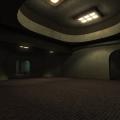-
Posts
568 -
Joined
-
Last visited
Content Type
News Articles
Tutorials
Forums
Downloads
Everything posted by MoonDog
-
Do you have a combat mock up available for testing yet? Do that ASAP. Send it to me.
-
- 27 comments
-
- JKHub Exclusive
- Star Wars Related
-
(and 3 more)
Tagged with:
-
You don't need the internet. Pick apart the scripts that came in the pk3s, look through the entity list that comes with gtkradiant in base/scripts. Look at sample maps. Extract ents from other maps. My point is you'll be a lot better at it once you figure things out for yourself.
-
-
MUG's videos most likely. He forces the whole 1.3.12 thing.
-
It took my roughly 2 weeks, working a couple hours every other day to learn to do all that and more.
-
It looks exactly like the shader remaps that Sword did on his FFA3 entity mod years before either of you touched an entity...
-
That's all pretty basic stuff. I'd say dig into stock scripts and scripts from other maps and learn how to do it yourself. Look into all the entities as well, and how they can be chained. I could tell you how to do all of that, but you REALLY should learn it on your own. You'd be a stronger modder.
-
That's all that matters.
-

Star Wars Episode VII Discussion
MoonDog replied to Circa's topic in Star Wars Franchise Discussions
Only if Mark Hamill does his joker voice may he return. -
Fuck. Now I have to watch the Wrath of Kahn.
-
Read the title.
-
I never said you should make Icarus scripts in notepad. The drag and drop model may be a "lifesaver" but Icarus is an extremely weak scripting language.
-
I like it. Seems better put together than the other ones. I'd have to test it myself to give you more detailed feedback and criticism. Good work!
-
I had one. IP.Board butchered it. It was never fixed, and I had no interest in spending hours fixing something simply because I wanted to edit a post to add spoiler tags. :\
-
Most level designers are not architects. Most level designers haven't taken any architecture classes. *edit* Let me help you iterate. Ask yourself some questions and then add as you see fit. -How is power transfered? Wires, pipe runs, embedded transformers, etc..? If there are wires and pipes, how are are they ran? -Clearly this environment should have allowances for the human element. How is fresh water/sewage/waste water routed? Are there latices on the floor that cover pipe runs? Does your ducting have logical end points? Are these elements consistant? These are simple questions you can use to enrich your environment.
-
lol@fluent at drag and drop scripting. That's like saying "I'm fluent at breathing."
-
I wasn't entirely referring to the texture.
-
Floors and ceilings are looking a little same-y. Other than that good work so far.
-
I know. I used to use GTKRadiant and make stuff for JKA. I like to rattle JKA mappers cages from time to time by reminding them of how inferior the mapping is to newer stuff.
-
Good tutorials. You know what I like about codradiant? Terrain meshes. Manipulate and shape them however you want without bothering with quad soup or tri soup. Want to alpha blend? Copy and paste the mesh, select the alpha texture, select the vertices and manipulate the alpha values right there in the editor, seeing your blending in real time. ahhhhhhhhhhhhh. So good.
-
You need to have your misc_bsp in portal'd void. I'm not sure how that happens tbh. All the external volumes are supposed to be carved away after BSP. IN ANY CASE! You can fix this a few ways. Noclip around the void with your saber out. When you hear your saber humming, you are in portaled void. Write down the coordinates. You could also get on top of the skybox for the map so you are on solid ground, spawn an X-wing and then just fly around shooting until you see the animations and hear the shooting. Write down the coordinates and use them.
-
Are you talking about misc_bsp entities inserted into a level? Q: How do I make teleports without using Ysalimari's or Force Boons? A: This concept is a little complicated, but not overly so. However, you may not understand it at first. I like to use 4 entities to do this, however you MAY use less. First we need a "trigger_multiple". Now, depending on the map you are modding, the bmodels will vary. If you have Boba Fett's UU, type !bmodels to get a list. Try to find one that's physical, and small. !modelshader works good for this(Tells you the textures a certain model uses. If its something like a trigger it will say, no shader/texture found. Meaning, this is an invisible entity. Usage: !modelshader *8) . This is important because you MUST specify a brush model for this entity, or you will get an error when you load the map. Let's look at an FFA3 example. { "classname" "trigger_multiple" "model" "*8" "target" "exampletele" "origin" "1646 -1364 292" "spawnflags" "2" "angle" "90" } As you can see on FFA3 I like to use *8. It's part of an elevator, so it's originally a func_door. However, since we are using an entity that is invisible, the model will likewise, be invisible. Now origin can't just be whatever you are looking at in the GPS/getcoords. We are cloning *8 for this. So, the position of the ORIGINAL *8 is treated as 0 0 0. So, you either have to do some math, or use Boba Fett's ultra utility(Highly Recomend!). Stand at the spot you want the trigger to be(Where you step to get teleported) and type !brushmoveorigin *8. It will give you the coordinates you need to use for the origin of the trigger. You may have to raise or lower Z depending on the Bmodel/position. *IMPORTANT* You are NOT changing the original *8 coding. You can leave that alone. Simply specify the "model" as *8 and you will have cloned it. Now for the other parts of the entity. I like to make it so you have to FACE the entity to use it. (I.E. you can't walk backwards through the tele and still use it.) To do that I simply add the spawnflag "2". (2 is facing). Since we added the facing spawnflag, we have to add the angle you need to face to use it now. "90" happens to be the direction I want people to face before they can use it. (If you need to get angles use Boba Fett's UU. Type !openmenu and navigate to the GPS. It will tell you the angle.) If you want to see other spawnflags I'd recommend downloading GTKRadiant and using the Entity List(N). It will calculate spawnflags for you if you don't have them memorized. Alright, let's move onto the other 3 entities we need. My "target" is "exampletele". So, let's keep that in mind when writing the next ents. Now we need the entity that actually does the teleporting. "classname" "target_teleporter". It need's to have the targetname specified in the trigger_multiple. Also, it will be targeting a "target_position"(Where you will be teleported to). So, let's write it out. { "classname" "target_teleporter" "targetname" "exampletele" "target" "exampleposition" } Well that was simple. Let's get the position. Go to where ever it is you want to be teleported to and use the GPS again if you have Boba Fett's UU. Note the origin and yaw(Angle you face when it spits you out at the position specified. Specify this with the "angle" key.) { "classname" "target_position" "origin" "20 20 20" "angle" "270" "targetname" "exampleposition" } Now this next part is completely optional. I like to print some text to tell people where they just ended up. To do this, you need a "target_print". It needs to have the same "targetname" as the target_teleporter. We want it to be triggered by the trigger_multiple at the same time. So, let's write it out and take a look. { "classname" "target_print" "targetname" "exampletele" "message" "You in the Ghetto neow" "spawnflags" "4" } Looking over it, its pretty self explanatory. In the message field you can use ^ color codes just like you do in game. Also, if you wanted to make a line break you'd use \n. Again we have a "spawnflags" key. On this entity "spawnflags" "4" makes it so only the person who triggered the Entity see's the text. If you left it out, everyone would see the text regardless of whether or not they teleported. So, here's the finished deal: (Let's use // to comment the entities, so we remember what teleport it is){ // Trigger multiple for my first tele ever "classname" "trigger_multiple" "model" "*8" "target" "exampletele" "origin" "20 23 20" "spawnflags" "2" "angle" "90" } { // Teleporter for first tele "classname" "target_teleporter" "targetname" "exampletele" "target" "exampleposition" } { // Position - first tele "classname" "target_position" "origin" "20 20 20" "angle" "270" "targetname" "exampleposition" } { // Text for first tele "classname" "target_print" "targetname" "exampletele" "message" "You in the Ghetto neow" "spawnflags" "4" } Also, for added effect, you can place a fx_runner over the spot the teleporter is to indicate its there. I like to use force/kothos_recharge to indicate the position of my ports. All the effects can be found in assets1.pk3 in your base folder. Just open up the effects folder within the pk3. Indicate the fx with "fxfile" and make sure you include the subfolder. You should end up with something like this: { // FFX for first tele "classname" "fx_runner" "fxfile" "force/kothos_recharge" "origin" "0 0 0" }




